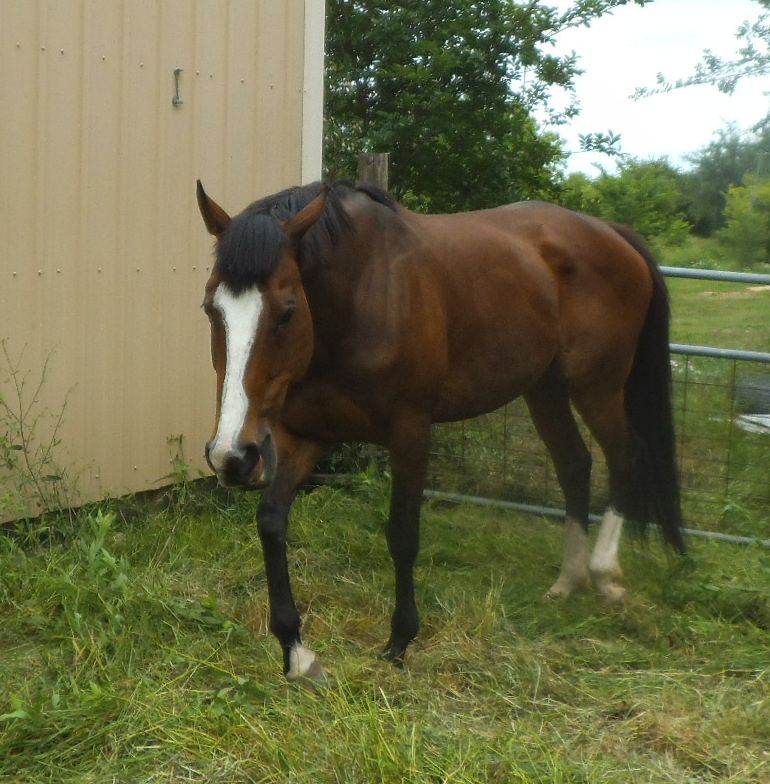About those feet
Time
heals all things...
Maybe, maybe not. Jury's still out on this one.

To lend credibility to this notion, when I struck out on
my own, I found two references that indicated the less you
mess with horses' feet, the better!
One was in an ancient veterinary manual, something I
imagined written in foggy England in the days of the
carriage. The advice there, after several pages of what
to do in increasingly more bizarre situations, was something
along the line of: "If none of
this works, pull the shoes and put the horse to pasture for
three months."
(Which, you kind of wonder, if that's what corrects it,
why isn't that part of horse keeping?)
The second reference was a more recent cowboy
type. By recent, this could've been someone working
cattle in the 50's. His take was that, "Come
summer, we always pulled the shoes and turned them
loose. By the time we were ready to start up again in
the Fall, everything was sorted out." I
vaguely recall this was prefaced with something along the
lines of 'if we had a horse whose feet seemed to be getting
out of alignment.' I'm also started to question
the whole Summer-Fall timeline. Wouldn't you be working
in the Summer? Maybe it was Winter-Spring? ANYWAY
- the idea is, you give the horse time off. You don't
ride it. You don't mess with it's feet. You let it
be a horse. And it gets better that way.
With the introduction of Paddock Paradise there are also
now many stories of horses being kept this way who, within
perhaps a year, have stellar feet.
The key to these three scenarios may well be there is
usually some patch of rough ground which serves as an emory
board of sorts. The parts of the hoof coming into
contact the most with the ground will provide the most support
and release to the body and will also be the most worn
down. This way the horse is
self-correcting skeletal and muscular issues at the same speed with
which the hoof is remodeling.
And, with my own crew, I have had very good success
recovering from 'traditional farriery.' And some
of what we've come back from was rather horrible. I
didn't take pictures because I was so ashamed I'd let that
happen. Also, because I didn't know if, really, it could
get better. (Mind you, I hired very expensive farriers!)(Don't
ask me how they got off in the weeds.)
So here comes Mia. Mia came to me with 'arthritis
in her front foot.'
And looking at her, I was thinking, there's something
mighty strange with that backend, too.
And from here I could easily segue off into like a
thousand different topics! None of this happens in a vacuum.
There is a feedback loop between the
skeleton, muscles, tendons, and hooves.
To keep to this topic, we pulled the (front)
shoes. All hooves showed adaptations. (AKA none of
the hooves were normal.) Both front feet were
'driftwood.' This means that they weren't well
oxygenated and weren't growing vigorously. (As a quick
aside, this means there wasn't any real circulation going on
in the foot -- something with health consequences on many
levels with the impact to hoof growth being the key to this
topic.) The hoof wall was weak and a bit shredded from
the nails. (She did have clips.) So it looked a
bit dicey from the gitgo. Whoever had done the shoes
before, I could understand what they were doing and it wasn't
a half bad thing, but I wanted more. I wanted healthy
feet. And I want to see about getting rid of that
arthritis.
To date -- we had several weeks of her usual movement. Then
we had a week of wonderful movement. Then I walked out
to the barn one morning to see a horse that wasn't walking at
all. PANIC.
Since then she's not been ridden, no lunging, no round
pen. I'm doing some myofascial release along with the
Ortho-Bionomy/Equine Positional Release. (I'll do a
different post to cover that!) I have also utilized
Vettec Equi-Pac and randomly slid a foam pad under various
feet.
We've had some good weeks, some bad days, a few more whiffs of
PANIC. This is not for the faint of heart!
Counting on my fingers, she's been here for four months,
although the shoes didn't get pulled right away.
Truthfully, that's depressing!
The good news, though, is that her feet *are* remodeling
into a much healthier shape and the thicker hoof wall is
making it's way down to the ground. I suspect we won't
make serious headway until the new growth starts connecting
with the ground. Which, that may be another half year of
so. Time to 'dig in' for the long haul. Time for
practicing patience. And persistence. We'll get
there, though.
When you're driving through hell, keep going!
L
|




![Centered Riding Today: An Informal Talk by Sally Swift [VHS]](http://ecx.images-amazon.com/images/I/41Vn6PfhzML._SL125_.jpg)
![Centered Riding with Sally Swift [VHS]](http://ecx.images-amazon.com/images/I/51OSh9kd9iL._SL125_.jpg)